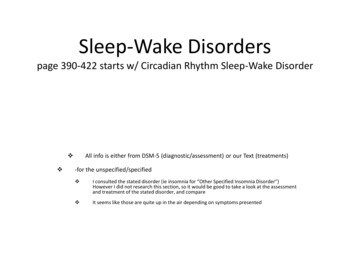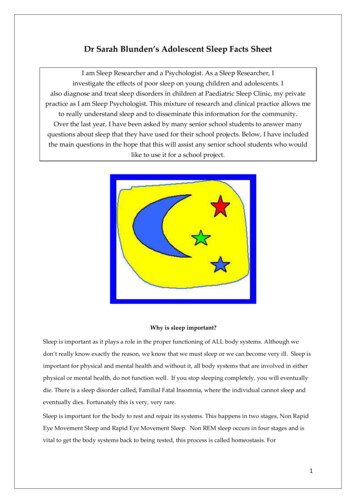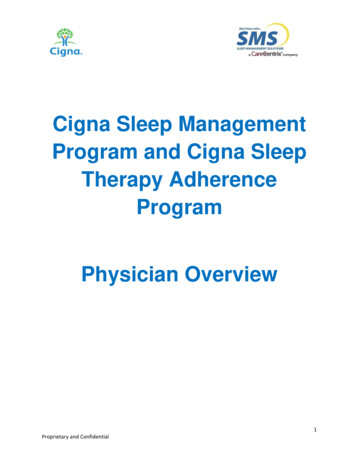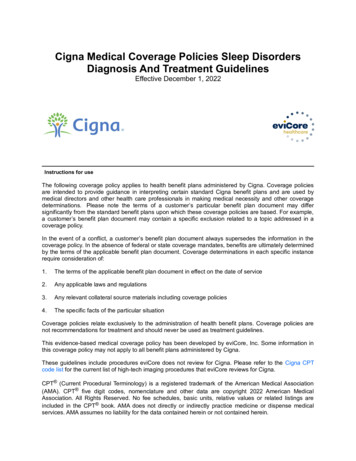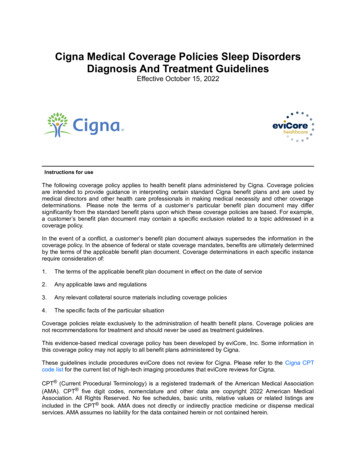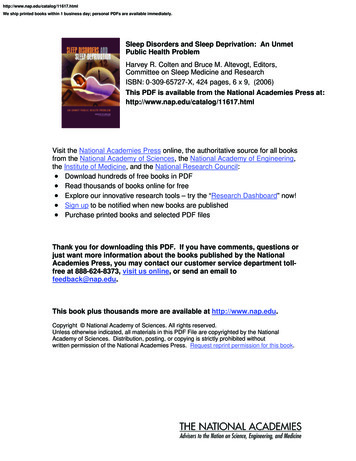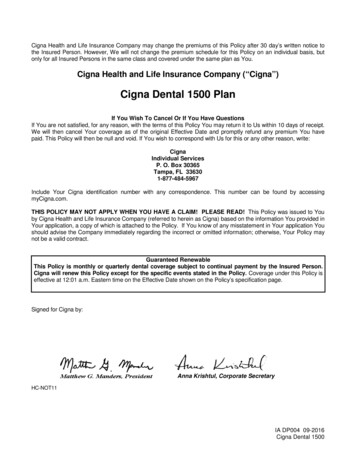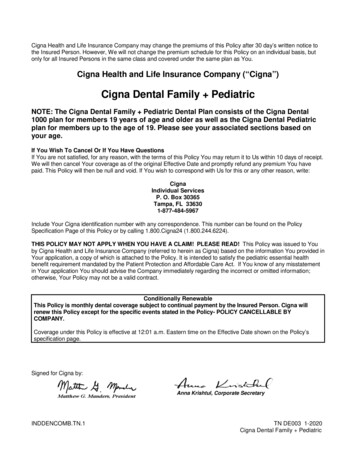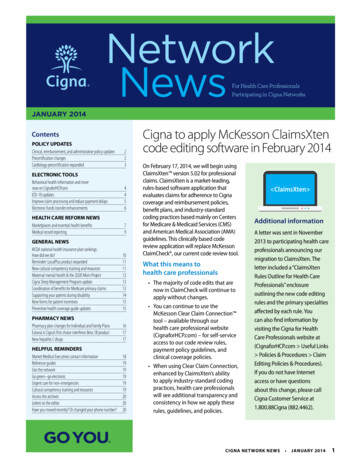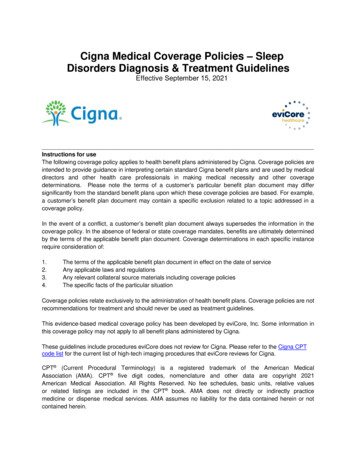
Transcription
Cigna Medical Coverage Policies – SleepDisorders Diagnosis & Treatment GuidelinesEffective September 15, 2021Instructions for useThe following coverage policy applies to health benefit plans administered by Cigna. Coverage policies areintended to provide guidance in interpreting certain standard Cigna benefit plans and are used by medicaldirectors and other health care professionals in making medical necessity and other coveragedeterminations. Please note the terms of a customer’s particular benefit plan document may differsignificantly from the standard benefit plans upon which these coverage policies are based. For example,a customer’s benefit plan document may contain a specific exclusion related to a topic addressed in acoverage policy.In the event of a conflict, a customer’s benefit plan document always supersedes the information in thecoverage policy. In the absence of federal or state coverage mandates, benefits are ultimately determinedby the terms of the applicable benefit plan document. Coverage determinations in each specific instancerequire consideration of:1.2.3.4.The terms of the applicable benefit plan document in effect on the date of serviceAny applicable laws and regulationsAny relevant collateral source materials including coverage policiesThe specific facts of the particular situationCoverage policies relate exclusively to the administration of health benefit plans. Coverage policies are notrecommendations for treatment and should never be used as treatment guidelines.This evidence-based medical coverage policy has been developed by eviCore, Inc. Some information inthis coverage policy may not apply to all benefit plans administered by Cigna.These guidelines include procedures eviCore does not review for Cigna. Please refer to the Cigna CPTcode list for the current list of high-tech imaging procedures that eviCore reviews for Cigna.CPT (Current Procedural Terminology) is a registered trademark of the American MedicalAssociation (AMA). CPT five digit codes, nomenclature and other data are copyright 2021American Medical Association. All Rights Reserved. No fee schedules, basic units, relative valuesor related listings are included in the CPT book. AMA does not directly or indirectly practicemedicine or dispense medical services. AMA assumes no liability for the data contained herein or notcontained herein.
Sleep Disorders Diagnosis & Treatment GuidelinesV2.0Sleep Disorders Diagnosis and TreatmentGuidelinesAbbreviations for Sleep Guidelines3Preface4SL-1: Obstructive Sleep Apnea and Other Sleep-related BreathingDisorders7SL-2: Indications/Diagnostic Testing14SL-3: Pediatric Sleep Guidelines26SL-4: Treatment of Obstructive Sleep Apnea (OSA) and Other Sleeprelated Breathing Disorders30SL-5: Sleep Apnea Treatment Program Exclusions43 SL-6: Actigraphy (CPT 95803)45SL-7: Practice Notes47SL-8: Questionnaires50SL-9: Oral Appliances for the Treatment of Obstructive SleepApnea56References59 2021 eviCore healthcare. All Rights Reserved.Page 2 of 62400 Buckwalter Place Boulevard, Bluffton, SC 29910 (800) 918-8924www.eviCore.com
Sleep Disorders Diagnosis & Treatment GuidelinesV2.0AHIAOSATF of MPSGRDIScreening Toolsfor Sleep DisordersOAAmerican Academy of Sleep MedicineApnea-Hypoxia Index:normal AHI 5mild OSA: AHI of 5 to 15moderate OSA: AHI of 15 to 30severe OSA: AHI of 30Adult Obstructive Sleep Apnea Task Force of the American Academyof Sleep MedicineAutotitrating positive airway pressureBody mass index (body weight divided by the square of the height)Continuous positive airway pressureDepartment of TransportationExcessive daytime sleepinessHealthcare Common Procedural Coding System(Level II alphanumeric codes used to report services not included inCPT )Home sleep apnea testingIndependent Diagnostic Testing FacilitiesJoint Commission on Accreditation of Healthcare OrganizationsMultiple Sleep Latency TestMaintenance of Wakefulness TestObstructive sleep apneaPortable monitoring (in home sleep studies)PolysomnographyRespiratory disturbance index: (respiratory effort related arousals apneas hypopneas/total sleep timenormal RDI 5mild OSA: RDI of 5 to 15moderate OSA: RDI of 15 to 30severe OSA: RDI of 30Epworth Sleepiness Scale, Berlin Questionnaire (for sleep apnea),STOP-BANG questionnaire, Insomnia Severity IndexOral appliance 2021 eviCore healthcare. All Rights Reserved.Page 3 of 62400 Buckwalter Place Boulevard, Bluffton, SC 29910 (800) 918-8924www.eviCore.comSleep Disorders: Diagnosis and TreatmentAbbreviations for Sleep GuidelinesAASM
Sleep Disorders Diagnosis & Treatment GuidelinesV2.0PrefacePreface-1: Guideline DevelopmentPreface-2: Benefits, Coverage Policies, and Eligibility Issues56 2021 eviCore healthcare. All Rights Reserved.Page 4 of 62400 Buckwalter Place Boulevard, Bluffton, SC 29910 (800) 918-8924www.eviCore.com
Sleep Disorders Diagnosis & Treatment GuidelinesV2.0Preface-1: Guideline Development The cobranded Cigna-eviCore healthcare (eviCore) evidence-based, proprietaryclinical guidelines evaluate a range of advanced imaging and procedures, includingNM, US, CT, MRI, PET, and Radiation Oncology, Sleep Studies and Cardiac andSpine interventions. Cigna and eviCore reserve the right to change and update the guidelines. Theguidelines undergo a formal review annually. The Cigna-eviCore guidelines arebased upon major national and international association and society guidelines andcriteria, peer-reviewed literature, major treatises as well as, input from health plans,practicing academic and community-based physicians. These Guidelines are not intended to supersede or replace sound medical judgment,but instead, should facilitate the identification of the most appropriate proceduregiven the individual’s clinical condition. These guidelines are written to cover medicalconditions as experienced by the majority of individuals. However, these guidelinesmay not be applicable in certain clinical circumstances, and physician judgment canoverride the guidelines. Cigna and eviCore support the Choosing Wisely initiative (www.choosingwisely.org)by the American Board of Internal Medicine (ABIM) Foundation and many nationalphysician organizations, to reduce the overuse of diagnostic tests that are low value,no value, or whose risks are greater than the benefits. The terms “male” and “female” used in these guidelines refer to anatomic-specificdiseases and disease predispositions associated with individuals’ sex assigned atbirth rather than their gender identity. It should be noted that gender identity andanatomic-specific diseases as well as disease predispositions are not always linked.As such, these guidelines should be applied to the individual’s corresponding knownor suspected anatomic-specific disease or disease predisposition. At Cigna andeviCore, we believe that it is important to understand how all individuals, includingthose who are gender-diverse, choose to identify themselves. To ensure thatgender-diverse individuals are treated with respect and that decisions impacting theirhealthcare are made correctly and with sensitivity, Cigna and eviCore recognize allindividuals with the following gender marker options: Male, Female, Transgendermale, Transgender female, “X”, and “Not specified”. 2021 eviCore healthcare. All Rights Reserved.Page 5 of 62400 Buckwalter Place Boulevard, Bluffton, SC 29910 (800) 918-8924www.eviCore.comSleep Disorders: Diagnosis and Treatment Clinical decisions, including treatment decisions, are the responsibility of theindividual and his/her provider. Clinicians are expected to use independent medicaljudgment, which takes into account the clinical circumstances to determine individualmanagement decisions.
Sleep Disorders Diagnosis & Treatment GuidelinesV2.0Preface-2: Benefits, Coverage Policies, and Eligibility Issues Medical benefits, plan coverage, and eligibility issues pertaining may takeprecedence over Cigna-eviCore’s cobranded guidelines.Medicare Coverage Policies For Medicare and Medicare Advantage enrollees, the coverage policies of CMS(Centers for Medicare and Medicaid Services) take precedence over CignaeviCore’s cobranded guidelines. CMS requires coverage for studies requested as part of a CMS approved clinicaltrial though the CMS CED program. A list of the currently approved studies isavailable ith-EvidenceDevelopment/IndexExperimental, Investigational, or Unproven StudiesClinical and Research Trials Similar to experimental, investigational, or unproven studies, clinical trial requestswill be considered to determine whether they meet coverage. Services inconsistent with established clinical standards or requested for datacollection and not for use in direct clinical management are not supported.References1. Prospective Payment Systems - General Information. CMS. ce-Payment/ProspMedicareFeeSvcPmtGen.2. Medicares Coverage with Evidence Development: A Policy-Making Tool in Evolution. Journal ofOncology Practice. 2007;3(6):296-301. doi:10.1200/jop.0763501.3. Coverage of Clinical Trials under the Patient Protection and Affordable Care Act; 42 U.S.C.A. §300gg-8. 2021 eviCore healthcare. All Rights Reserved.Page 6 of 62400 Buckwalter Place Boulevard, Bluffton, SC 29910 (800) 918-8924www.eviCore.comSleep Disorders: Diagnosis and Treatment Certain studies described in these guidelines are considered experimental.Investigational, or unproven. Certain procedures may be considered experimental,investigational, or unproven if there is a paucity of supporting evidence; if theevidence has not matured to exhibit improved health parameters or; the procedurelacks a collective opinion of support.
Sleep Disorders Diagnosis & Treatment GuidelinesV2.0SL-1: Obstructive Sleep Apnea and OtherSleep-related Breathing DisordersSL-1.0: General GuidelinesSL-1.3: Classifications of sleep-related breathing disordersSL-1.4: CodingSL-1.4.1: Home Portable Monitoring (PM) (Home Sleep Testing) CodingSL-1.4.2: Polysomnography (Facility-based-PSG) - Coding811121213 2021 eviCore healthcare. All Rights Reserved.Page 7 of 62400 Buckwalter Place Boulevard, Bluffton, SC 29910 (800) 918-8924www.eviCore.com
Sleep Disorders Diagnosis & Treatment GuidelinesV2.0 A current and comprehensive clinical evaluation (within 60 days) by the treatingmedical provider, either face to face or telehealth, is required before a sleep studycan be considered. (Note: The rendering site must be a qualified provider of serviceper health plan policy). The clinical evaluation may include a relevant history andphysical examination, appropriate laboratory studies, and other relevant diagnosticstudies (such as a previous sleep study or overnight pulse oximetry). The results ofa sleep questionnaire or sleep questionnaire proxy are required. See: SleepQuestionnaires. Documented history may include the following: Persistent symptoms present for greater than 4 weeks in duration and notassociated with respiratory infections. House partners/spouses can describe symptoms, including apneic spells,such as gasping and choking. Co-workers, friends, and/or the individual may report that the individual fallsasleep during business meetings, conversations, while stopped at trafficlights, or while driving. Daytime tiredness and excessive caffeine or stimulant use. Excessively loud, erratic and variable snoring. (Note: Snoring alone is notalways indicative of OSA). Frequent awakening during the night. Increased movements, sleep talking, displaying confused or erratic behaviorduring sleep. Morning headaches, limited attention, or memory loss. Drowsy driving or history of car crashes or near miss accidents related tosleepiness. Prior diagnosis of OSA and response to therapy. Documented physical examination should include: Cardiopulmonary evaluation Level of obesity and/or neck circumference Other findings, such as: macroglossia, tonsillar hypertrophy, nasal polyps,septal deviation, turbinate hypertrophy, elongated/enlarged uvula,narrow/high arched hard palate retrognathia (recessed mandible) ormicrognathia (small mandible).NoteHSAT and/or PSG must be ordered by a treating medical provider and interpreted by aboard-certified sleep medicine physician or a provider that is overseen by a boardcertified sleep medicine physician 2021 eviCore healthcare. All Rights Reserved.Page 8 of 62400 Buckwalter Place Boulevard, Bluffton, SC 29910 (800) 918-8924www.eviCore.comSleep Disorders: Diagnosis and TreatmentSL-1.0: General Guidelines
Sleep Disorders Diagnosis & Treatment GuidelinesV2.0 For the purpose of this guideline, criteria for sleep-related breathing disorders aredefined as follows: Obstructive sleep apnea (OSA) as measured by valid testing is defined as: The apnea-hypopnea index (AHI), respiratory disturbance index (RDI),respiratory event index (REI) is 15 events per hour; or The AHI, RDI, or REI is 5 and 15 events per hour and documentation of: Symptoms of sleepiness, nonrestorative sleep, fatigue, or insomnia Report of awakening with breath holding, gasping, or choking Bed partner or other observer reports habitual snoring, breathinginterruptions, or both during sleep Hypertension, a mood disorder, cognitive dysfunction, coronary arterydisease, congestive heart failure, atrial fibrillation, type 2 diabetes mellitus,or stroke. Central sleep apnea (CSA) defined as (both): Central hypopnea/apneas are 50% of total Central apnea and/or central hypopnea index 5 per hour Central sleep apnea (CSA) with Cheyne-Stokes Respiration defined as (all): Central hypopnea/apneas are 50% of total Central apnea and/or central hypopnea index 5 per hour Pattern of breathing meets criteria for Cheyne-Stokes breathing i.e. periodicbreathing characterized by the waxing and waning of respiratory effort andairflow (crescendo and decrescendo change in breathing amplitude) Treatment Emergent Central Sleep Apnea defined as (both): Diagnostic PSG demonstrates 5 or more obstructive respiratory events perhour of sleep PSG during use of positive airway pressure shows improvement ofobstructive events and emergence or persistence of centralapneas/hypopneas with (both): Central apnea and/or hypopnea index 5 per hour Central hypopnea/apneas are 50% of total Sleep-related hypoventilation defined as when either of the following occur duringsleep: Increase in arterial PCO2, transcutaneous PCO2, or end-tidal PCO2 to a value 55 mmHg for 10 minutes There is a 10 mmHg increase in arterial PCO2, transcutaneous PCO2, orend-tidal PCO2 during sleep (compared to awake supine value) to a value 50 mmHg for 10 minutes 2021 eviCore healthcare. All Rights Reserved.Page 9 of 62400 Buckwalter Place Boulevard, Bluffton, SC 29910 (800) 918-8924www.eviCore.comSleep Disorders: Diagnosis and TreatmentDefinitions
Sleep Disorders Diagnosis & Treatment GuidelinesV2.0Overutilization of Testing: A review of the testing history, including all of the following, avoids unnecessaryrepeat testing: The results of initial studies to narrow the differential diagnosis should beobtained prior to performing further tests The clinical history should include a potential indication such as a known orsuspected sleep disorder. These potential indications are addressed in greaterdetail within the applicable guidelines. The results of the requested study should be expected to have an impact onpatient management or treatment decisions. Criteria for repeat studies are addressed in the applicable guideline SL-2.6:Repeat Sleep Testing - (Home or Attended Sleep Studies) Testing when the same or similar studies have already been conducted is notindicated, without clear rationale that fulfills guideline criteria Four sleep questionnaires (all self-answered by the patient) are commonly used toquantify the level of sleepiness, quality of sleep or probability of having OSA. Thesevalidated questionnaires include (but are not be limited to): Epworth Sleepiness Scale Berlin Questionnaire STOP Bang Questionnaire Insomnia Severity Index The results of these questionnaires help formulate an individual’s likelihood ofhaving sleep-related disease, so the questionnaires must be appropriate for thespecific sleep issue in question (e.g. STOP-BANG and Berlin are most appropriatefor OSA evaluation). To view these questionnaires and their interpretation in their entirety, see SL-8:Questionnaires. Results of one of these four questionnaires are required, or the following conditioncan serve as a proxy for the sleep questionnaire requirement: Witnessed apnea by a bed partner Previous diagnosis of OSA confirmed in record by prior testing History and physical elements are provided that would permit calculation of theSTOP-BANG survey or Berlin Questionnaire 2021 eviCore healthcare. All Rights Reserved.Page 10 of 62400 Buckwalter Place Boulevard, Bluffton, SC 29910 (800) 918-8924www.eviCore.comSleep Disorders: Diagnosis and TreatmentSleep Questionnaires:
Sleep Disorders Diagnosis & Treatment GuidelinesV2.0 Sleep apnea is defined as repetitive partial or complete cessations of breathing thatoccur during sleep. These breathing events can be caused by a physical obstructionof the upper airway, a lack of effort to breathe, or a combination of these two factors.The source of the sleep disordered breathing determines the type or classification ofsleep apnea. Obstructive sleep apnea (OSA): OSA is caused by a physical obstruction in the upper airway. Sleep study recording characterized by: Loud snoring Obstructive apnea events – scored as apneas with apnea index or AI Hypopnea events – scored with hypopnea index or HI Significant oxyhemoglobin desaturations Arousals from sleep Central sleep apnea (CSA) defined as Central hypopnea/apneas are 50% oftotal, and Central apnea and/or central hypopnea index 5 per hour: CSA is caused by a reduction or absence of effort to breathe by thediaphragm or respiratory muscles. Sleep study recording characterized by: Central apnea events, or hypopnea events Occasional snoring Oxyhemoglobin desaturation Occasional arousals from sleep Central sleep apnea (CSA) with Cheyne-Stokes Respiration defined as Centralhypopnea/apneas are 50% of total, and Central apnea and/or central hypopneaindex 5 per hour and the pattern of breathing meets criteria for Cheyne-Stokesbreathing: CSR is a form of periodic breathing characterized by the waxing and waningof respiratory effort and airflow CSR generally starts with a gradual waning of breathing effort and airflowwhich results in a central apnea, or hypopnea, followed by a gradual increasein breathing effort and flow Sleep-related hypoventilation as defined when either of the below occur duringsleep: Increase in arterial PCO2, transcutaneous PCO2, or end-tidal PCO2 to a value 55 mmHg for 10 minutes There is a 10 mmHg increase in arterial PCO2, transcutaneous PCO2, orend-tidal PCO2 during sleep (compared to awake supine value) to a value 50 mmHg for 10 minutes Treatment emergent central sleep apnea (complex sleep apnea) as measured byvalid testing is defined as: Diagnostic PSG demonstrates 5 or more obstructive respiratory events perhour of sleep PSG during use of positive airway pressure shows improvement ofobstructive events and emergence or persistence of centralapneas/hypopneas with: 2021 eviCore healthcare. All Rights Reserved.Page 11 of 62400 Buckwalter Place Boulevard, Bluffton, SC 29910 (800) 918-8924www.eviCore.comSleep Disorders: Diagnosis and TreatmentSL-1.3: Classifications of sleep-related breathing disorders
Sleep Disorders Diagnosis & Treatment Guidelines V2.0Central apnea and/or hypopnea index 5 per hour andCentral hypopnea/apneas are 50% of totalSL-1.4: CodingSL-1.4.1: Home Portable Monitoring (PM) (Home Sleep Testing) CodingThere are currently 3 levels (HCPCS G0398, G0399 and G0400) of home PM’s, withvarying number of monitored parameters. Each can be used with or without anattendant but are generally performed unattended in the individual’s home.Home sleep study test (HSAT) with type IIportable monitor, unattended; minimum of 7channels: EEG, EOG, EMG, ECG/heart rate,airflow, respiratory effort and oxygen saturationHome sleep test (HSAT) with type III portablemonitor, unattended; minimum of 4 channels: 2respiratory movement/airflow, 1 ECG/heartrate and 1 oxygen saturationHome sleep test (HSAT) with type IV portablemonitor, unattended; minimum of 3 channelsHCPCSChannelsG0398At least 7 monitored channels.Can calculate AHI.G0399At least 4 monitored channels(airflow/ventilation, heart rate,oxygen saturation, respiratorymovement)G0400Measures 1 to 3 parametersPSG PROCEDURE CODESUnattended Sleep StudiesCPT Sleep study, unattended, measures a minimum of heart rate, oxygen saturation, andrespiratory analysis (e.g., by airflow or peripheral arterial tone), and sleep time.95800 Simultaneous recording; simultaneous recording; heart rate, oxygen saturation, andrespiratory analysis (e.g., by airflow or peripheral arterial tone), and sleep time. For unattended sleep study that measures a minimum of heart rate, oxygen saturation,and respiratory analysis, report 95801Sleep study, unattended, measures a minimum of heart rate, oxygen saturation, and95801respiratory analysis (e.g., by airflow or peripheral arterial tone) Simultaneous recording; minimum of heart rate, oxygen saturation, and respiratoryanalysis (e.g., by airflow or peripheral arterial tone). For unattended sleep study that measures a minimum of heart rate, oxygen saturation,and sleep time, report 95800Sleep study, unattended, simultaneous recording of heart rate, oxygen saturation,95806respiratory airflow and respiratory effort (e.g. thoracoabdominal movement) Simultaneous recording; minimum of ventilation, respiratory effort, ECG or heart rate, andoxygen saturation. Do not report CPT 95806 in conjunction with any of the following codes: CPT 9304193229, 93268-93272, or 95800-95801 2021 eviCore healthcare. All Rights Reserved.Page 12 of 62400 Buckwalter Place Boulevard, Bluffton, SC 29910 (800) 918-8924www.eviCore.comSleep Disorders: Diagnosis and TreatmentHome Sleep Studies
Sleep Disorders Diagnosis & Treatment GuidelinesV2.0SL-1.4.2: Polysomnography (Facility-based-PSG) - CodingPSG PROCEDURE CODESCPT Multiple sleep latency or maintenance of wakefulness testing, recording, analysisand interpretation of physiological measurements of sleep during multiple trials to95805assess sleepiness or ability to remain awake. Multiple sleep latency testing (MSLT) is performed prior to treatment when the requestingphysician suspects narcolepsy. MSLT must be requested with a facility sleep study performed the night before the 95805(CPT 95810 or CPT 95811). See SL-2.3: PSG and Multiple Sleep Latency Testing (excessive sleepiness) - SeeSL-2.4: Maintenance of Wakefulness Testing (MWT)-Indications and CriteriaPolysomnography; (any age), sleep staging with 1-3 additional parameters of95808sleep, attended by a technologistSleep study, simultaneous recording of ventilation, respiratory effort, ECG or heart95807rate, and oxygen saturation, attended by a technologist with PAP titration, May be considered experimental, investigational, or unproven when 95807 or 95807-52 isutilized to request a PAP-NAP.Attended Polysomnography and Sleep StudiesCPT Polysomnography; (age 6 years or older), sleep staging with 4 or more additional95810parameters of sleep, attended by a technologist. CPT 95810 is used to report full-night studies. One of the more common studies.Polysomnography; (age 6 years or older), sleep staging with 4 or more additionalparameters of sleep, with initiation of continuous positive airway pressure therapy95811or Bi-level ventilation, attended by a technologist One of the more common studies. CPT 95811 is used either as either a split-night study with both the diagnostic study andthe subsequent positive airway pressure or bi-level ventilation are initiated during thesame visit, or as PAP titration alone after CPT 95810 or inability to complete split nightsequence or as a retitration of PAP therapy.Attended Polysomnography and Sleep Studies (PEDIATRIC CODES)CPT Polysomnography, (younger than 6 years), sleep staging with 4 or more additional95782parameters of sleep, attended by a technologist.Polysomnography, (younger than 6 years), sleep staging with 4 or more additionalparameters of sleep, with initiation of continuous positive airway pressure therapy95783or bi-level ventilation, attended by a technologist. 2021 eviCore healthcare. All Rights Reserved.Page 13 of 62400 Buckwalter Place Boulevard, Bluffton, SC 29910 (800) 918-8924www.eviCore.comSleep Disorders: Diagnosis and TreatmentAttended Polysomnography and Sleep Studies
Sleep Disorders Diagnosis & Treatment GuidelinesV2.0SL-2: Indications/Diagnostic TestingSL-2.1: Home Sleep Apnea Testing (HSAT) IndicationsSL-2.2: In-Laboratory Polysomnography - OSA IndicationsSL-2.2.1: In-Laboratory Polysomnography - Other IndicationsSL-2.3: PSG and Multiple Sleep Latency Testing (excessivesleepiness)SL-2.4: Maintenance of Wakefulness Testing (MWT) - Indicationsand CriteriaSL-2.5: Split Night Study or Two Night StudySL-2.6: Repeat Sleep Testing - (Home or Attended Sleep Studies)SL-2.6.1: Repeat Diagnostic StudySL-2.6.2 Repeat TitrationSL-2.6.3: Re-assessment of suspected narcolepsy or idiopathichypersomniaSL-2.7: PAP-NAP (CPT 95807-52)SL-2.8: Diagnostic Testing pre- and post- hypoglossal nervestimulator implantation151517181821222222232324 2021 eviCore healthcare. All Rights Reserved.Page 14 of 62400 Buckwalter Place Boulevard, Bluffton, SC 29910 (800) 918-8924www.eviCore.com
Sleep Disorders Diagnosis & Treatment GuidelinesV2.0SL-2.1: Home Sleep Apnea Testing (HSAT) Indications HSAT can be performed when both of the following criteria are met: High pre-test probability of moderate-to-severe OSA as defined by validatedquestionnaire or reported symptoms of excessive daytime sleepiness and atleast two of the following three criteria (habitual loud snoring, witnessed apneaor gasping or choking, or diagnosed hypertension) and HSAT can physically be performed and individual has the mobility, dexterity andcognitive ability to use the available equipment safely at home and the ability tofollow instructions Individuals who exhibit one of the co-morbid indications for attended sleep studiesfound in SL-2.2: In-Laboratory Polysomnography - OSA Indications can undergofacility testing as outlined in SL 2.2 or home sleep apnea testing (HSAT) if preferredby the treating provider HSAT can also be used in follow-up treatment results after any of the following: Surgical treatment for moderate to severe OSA OSA Oral appliance trial Other non-PAP supportive interventions (e.g. positional therapy).SL-2.2: In-Laboratory Polysomnography - OSA Indications Sleep survey or proxy symptom(s) lead to any pretest probability of OSA and one ofthe following: HSAT cannot be done due to one of the following reasons: OSA symptoms with low pretest probability of OSA. Individual does not have the mobility, dexterity or cognitive ability to use theavailable equipment safely at home and the ability to follow instructions. HSAT has been attempted and is negative, inconclusive, or technicallyinadequate (report submitted for review). Documentation of at least one of the following suspected or known co-morbiddiagnoses: Morbid obesity and one of the following: BMI 45 Obesity Hypoventilation Syndrome (OHS) defined as BMI 30 plusarterial blood gas with PCO2 45. If ABG results are not available, serum bicarbonate 27 may be providedas an alternative to determine high risk for OHS). Moderate to severe pulmonary disease (for example: COPD, asthma) asdemonstrated by one or more of the following: nocturnal oxygen use documented arterial blood gases showing PO2 60 or PCO2 45 documented pulmonary function tests demonstrating moderate to severeobstruction with forced expiratory volume in one second (FEV1) 69% ofpredicted 2021 eviCore healthcare. All Rights Reserved.Page 15 of 62400 Buckwalter Place Boulevard, Bluffton, SC 29910 (800) 918-8924www.eviCore.comSleep Disorders: Diagnosis and TreatmentPSG(CPT 95810 or 95811) can be considered for the following:
V2.0 Documented neuromuscular disease (e.g., Parkinson’s, documented strokeor undocumented stroke with residua, active epilepsy, myotonic dystrophy,ALS) Moderate to severe congestive heart failure with documented pulmonarycongestion or known left ventricular ejection fraction 45% Pulmonary HTN, with documentation of a mean pulmonary artery pressure of 25 mm Hg on right heart cardiac catheterization. Note: If right heartcatheterization results are not available, echocardiography results can beprovided documenting significant probability of pulmonary HTN based on apeak tricuspid regurgitation velocity of 2.9 m/s Other critical illness that would prevent them from using the HSAT equipment. Chronic severe insomnia (by objective measure e.g. sleep diary, validatedinsomnia questionnaire, such as Insomnia Severity Index 22) Chronic daily opioid use (typically daily high-potency opioids e.g.Methadone , Suboxone , Dilaudid ) with stated concern for presence ofcentral sleep apnea. Bi-level PAP or Adaptive Servo Ventilation PAP are specifically requested(Titration study, CPT 95811, only) and CPAP has already been tried andproven ineffective or not tolerated for an individual with OSA OR theindividual has been diagnosed with one of the conditions outlined in SL4.2.3: Bilevel Positive Airway Pressure – spontaneous mode, SL4.2.4: Bilevel Positive Airway Pressure – spontaneous/timed mode, orSL-4.2.6: Adaptive Servo Ventilation (ASV) therapy (E0471), meetingcriteria for Bilevel Positive Airway Pres
Cigna and eviCore reserve the right to change and update the guidelines. The guidelines undergo a formal review annually. The Cigna-eviCore guidelines are . either face to face or telehealth, is required before a sleep study can be considered. (Note: The rendering site must be a qualified provider of service
